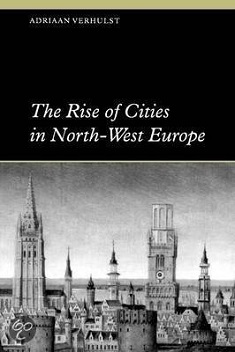
The Rise of Cities in North-West Europe
Adriaan Verhulst
172 pages including bibliography and index
published in 1999
Sometimes I'm unsure myself why I persist in reading a book I'm not getting any enjoyment from nor learn much from, but apparantly my boredom threshold is much higher for non-fiction books. The Rise of Cities in North-West Europe is one of those deceptively slim volumes of history that promise more than they deliver, looked much more interesting on the library shelves than it turned out to be. But is that the fault of the writer or the reader, coming to the subject cold and wanting a more pop historical approach?
Nevertheless, there is the question of the title. It's a bit overbroad for what turns out to be a historical and archaeological survey of the origins of cities in the region between the rivers Somme and Meuse, not entirely what I'd call "North-West Europe" myself. To be honest however, this is the most urbanised area of North-West Europe in the period Verhulst examines here, from the late Roman period up to the twelfth century. And Verhulst is careful not to draw wider conclusions from the fifteen cities he studied in detail here.
The impulse to write this book, according to the introduction was because the subject hadn't had a proper treatment in half a century and new research had made much of it outdated. The explanations offered for why this region in particular had such a rapid and early urbanisation when comparable regions elsewhere in Europe were no longer seen as sufficient. This book then is an attempt to tell the history of this urbanisation better. Whereas previously it was thought that long distance trade between the Southern Netherlands and the Mediterranean regions was the impulse that drove these cities to expand, Verhulst argues that instead the reasons should be found in the region's own particular circumstances.
One of which is of course the location of this region, criss crossed with excellent waterways, though some of which only became navigable in the period discussed, excellently positioned for trade with e.g. England or Northern France. At first this trade flowed through socalled emporia, trading places under protection of a king or located near large abbeys and royal residences. When these disappeared, trade switched to towns and cities, as the merchants no longer were bound to the manors of the church or their lord. The weakness of the manorial economy in this region, also enabled artisans to move out from the manors to the towns.
The South-Western Netherlands had from the end of the great migrations of Germanic peoples been more densely populated than was the norm in Europe, with agriculture being more advanced, again enabling the growth of larger and more cities than could be supported elsewhere. Combine that with a more splintered political environment, with no strong king to curb the independence of the cities and you have a recipe for growth.
The Rise of Cities in North-West Europe was an interesting, if tough read. One of those books that's not entirely meant as a general history, but more as a synthetic overview, more of use to an actual historian. One of those books you can't quite recommend, through no fault of its own.
Webpage created 15-01-2015, last updated 14-02-2015.